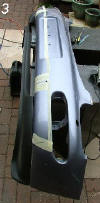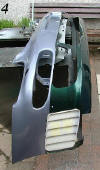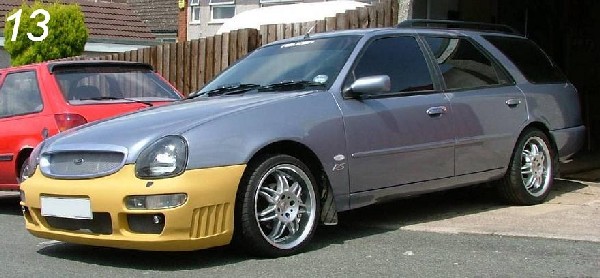Richard S announced on the Forum that
he was modding his front bumper. After a few weeks he had got
to the pre-paint stage and put up a photo of the result so far. The quality of his work
is amazing and I asked him to explain how he accomplished this for other Ford
Scorpio owners.

These are his instructions and photos
of the process.
Firstly, you need to find a shape
that you think might look good on the car. Personally, I
like the shape of the RS bumpers that are made mostly for Audi/VW cars, So I
guess I was lucky when I found a bumper sticking out of a skip at a local bodyshop. I went in and asked if
I could take it and they agreed. When I got it home I found there to be hardly any damage, just two small marks through
into the plastic.
I offered it up to the car and found it to be of the same width so I proceeded
to cut off about six inches from the top leaving the bottom half to be attached
to the existing bumper.
.

Pic 1.
Test fitted cut bumper onto Scorpio bumper. This is where you have to try and
visualize what your creation may look like. Once you have a mental picture you have
to mark up the bumper where you want to cut it.

Pic 2.
Cut bumper now mounted temporary with screws, note still not removed all of
shape as yet for added strength.

Pic 3. Using masking tape, transfer
marks from new to old bumper where you want to cut. I used a jigsaw for
this but it tends to melt the plastic as you cut and weld itself back together.
This takes patience and care.

Pic 4. The lower half of the stock bumper now removed, the new mod fixed
on with screws again, I cut approx 3 inches from the ends to put onto the wheel
end of the bumper to make a former for the GRP. I traced around Sierra Cosworth vents
to cut the sides out of the bumper to allow flush mounting , then used this piece to make
up below the vent; this had to be cut.

Pic 5. The assembly is now remounted back on to the car to get another visual and
to check clearances etc. Now this is
where it jumps a bit as I didn't take any pix of the fibre glass - (It's a
sticky mess you see, I didn't want to damage my new camera), so I'll do my best
without pictures.
Imagine the bumper as in Pic 4: in this position you have
to lay the fibre glass on, only mix enough resin for 30 mins working at a time.
(If you haven't used GRP before read up on it before you make a start, you'll
find loads about it on the web)
Cut strips about 3 X 6 inches and lay them onto
the bumper. You need to cover the whole lot at least 2-3 times with standard
mat, as I was scratch building and not using a mould I just let the fully wetted
out mat hang to form the shapes for the front as they would hang vertically in
this position. When you are happy with this you can add more layers it has cured.
Once this has been done you can start
on the back where any strength you think may be needed. If you are leaving the
new plastic bumper in place don't forget to rub this down with a rough abrasive
to give a good key and wrap the fibre glass around from front to back to stop
any movement.
When cured I used a dremmel-type tool to cut and tidy all the
rear of the scoops that have been created for the mesh to sit properly. Now
I
sanded the whole front with a belt sander, and I didn't forget to use a mask!

Pics 6 and 7. Now for filling, and I used Upol easy sand filler. Filler, as its
name implied, is used to fill in cuts, dimpling and imperfections. Again as with the
resin only mix enough to use - 20 mins this time. Cover everything you think
needs it, wait for this to go hard and start rubbing down.

Start with a rubber
block and a grade 40 paper. Keep doing this filling and rubbing down with
different grades of paper, up to a 400 grade until you are happy with the
result.

Pic 8. The Grille.
I cut the ribs out with a hacksaw and used the mini tool again to tidy up the
edges,I roughed up the chrome outer and then placed it as i did the bumper, Then
more fibre glassing, same process again, starting from the outermost part of the
chrome edge and letting the mat curl around the edge
of the chrome and into where the mesh will be, let this cure then repeat. When
happy with the result it was on with the filler, again starting with 40 and working up to 400 grade
paper rub down fill etc.

Pic 9.
Had to fabricate a new bonnet release mechanism as the old one has been cut off
the grille. I used 14mm tube from a DIY store and then welded this together to a
new design of my own.

Pics 10 and 11:-

Back onto car for final checks to make sure all
is ok.

Pics 12,13.
Primer applied, This is first coat spray putty, to take out any little marks
that may be left in the filler or GRP, note this won't take out big marks or
imperfections that actually need filler.

Second coat was a spray putty/primer filler
mix as I was not happy with the first coat. The next step will be flatting the bumper
with a 600 wet paper and give it the final coat of primer before the basecoat
and lacquer are applied.
Note in Pic14 (top of page)
the grille mesh is now silver and looks far better, and spotlights are fitted under the indicators.
Costs
Molders Resin 5kg £20 (The cheap stuff will do if using this method
as there is no mould)
Fibre glass mat 3m £6
Quick sand filler
£10-15
Spray putty 1ltr
£6
Metal tube 1m
£2
Various finishing papers £5-10
Paint,
Primer 1ltr
£6
Polyester basecoat 1ltr £15
Lacquer 1ltr
£8
Time and patience Lots
Thanks to Richard S for the pix and text.

